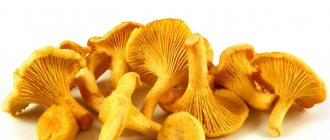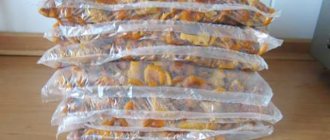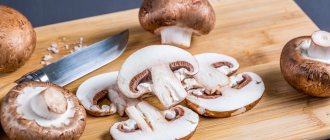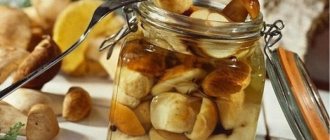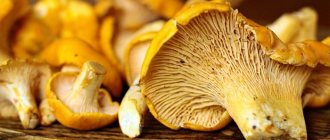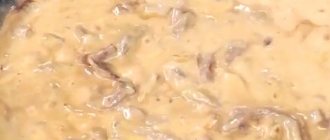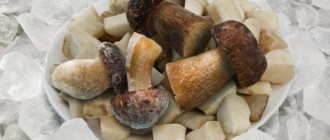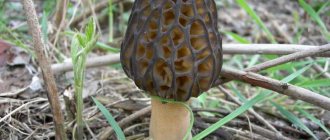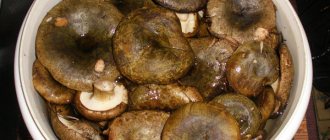How to properly cook porcini mushroom?
Porcini mushrooms take 35-40 minutes to cook; if you plan to fry them later, 20 minutes is enough. Before adding porcini mushrooms to the pan, they must be cleaned and rinsed thoroughly. When cooking, it is necessary to regularly remove the foam. Soak dried porcini mushrooms for 2-3 hours, then cook for 20 minutes.
Interesting materials:
What colors need to be mixed to get dark burgundy? What colors are yellow? What colors go with dark purple? What colors are in fashion for fall winter 2022? What colored pencils do artists use? What colored pencils are best for an artist? What flowers are most often used in bouquets? What kind of flowers do you give to a girl you like? What flowers should be in the second youngest group? What flowers can be kept at school?
Why are mushrooms bitter: is it dangerous to eat?
Let's find out if you can eat bitter mushrooms...
The problem of why mushrooms are bitter is a very common one. In many cases, such mushrooms are not edible. Let's figure it out.
What can cause mushrooms to taste bitter?
You should always pick mushrooms very carefully: if you are not sure that a mushroom is edible, it is better not to pick it! Many “false” mushrooms are successfully disguised as “good” ones - boletus mushrooms, boletus mushrooms, honey mushrooms.
Poisonous mushrooms always look more beautiful than edible ones; insects and worms practically do not eat them, due to their extreme bitterness
Of the edible mushrooms, the milk mushrooms are considered the most bitter. These are milk mushrooms, milk mushrooms, chanterelles, even saffron milk caps and boletus can be slightly bitter.
What mushrooms are bitter?
Old mushrooms damaged by pests, as well as those collected in areas contaminated with radionuclides and pesticides, are usually very bitter. If both summer and autumn were dry, then the question of why mushrooms are bitter will probably arise. Those mushrooms that grow in coniferous forests are more bitter than those growing under deciduous trees.
How to eliminate the bitterness of mushrooms
The bitterness can be partially eliminated during processing. To do this, mushroom fruiting bodies are soaked in clean, preferably spring or filtered water, for several days. It is better to boil the mushrooms for 20-30 minutes, changing the water twice.
If after soaking and boiling the mushrooms remain bitter, then perhaps there was one poisonous one among them, so all the mushrooms that were cooked with it will have to be thrown away so as not to get poisoned
Having determined for sure why mushrooms are bitter, it is easier to figure out whether they are worth eating.
Source
Recipe for pickling rows that taste bitter
Although the rows are bitter, when pickled they are simply amazingly tasty. Try making this recipe for the winter and you will definitely love it!
- 2 kg of mushrooms;
- 800 ml water;
- 2 d.t. l. salt;
- 3 tbsp. l. Sahara;
- 50 ml vinegar 9%;
- 4 cloves of garlic;
- 5 peas each of allspice and black pepper;
- A pinch of cinnamon.
- The peeled rows are boiled in two waters with added salt for 20 minutes.
- Place in a colander and rinse in running water, allowing to drain well.
- Place the mushrooms in sterilized jars and prepare the marinade.
- Mix salt, sugar and all spices except vinegar in water and let it boil for 10 minutes.
- Add vinegar and cook over low heat for another 3-5 minutes.
- Fill the rows, cover with metal lids and place in hot water for 20 minutes for sterilization.
- Roll up, turn over, insulate and allow to cool in this position.
- Take out to a cool place and store for no more than 8 months.
Why are mushrooms bitter - several possible answers
Picking mushrooms is not only an exciting activity, but also a very responsible one. After all, by putting anything into a basket, you can poison yourself and endanger your loved ones. Inexperienced mushroom pickers, having studied what fly agaric and toadstool look like, think that this is enough to protect themselves from the poison growing in the forest. And having brought home a basket (or even two full buckets), these gatherers are already looking forward to a delicious meal. But in the end, you can’t take a single spoon into your mouth because of the acrid taste. Let's look at the reasons why mushrooms are bitter.
Ecology
In the question “why do mushrooms taste bitter”, one cannot discount the conditions in which the fruiting bodies grew. Their spongy structure absorbs everything that is carried in the air, spilled in groundwater or lying in the ground. Champignons found in city public gardens have been sprinkled not only by summer rain, but also by numerous dogs, so their taste is distinctly urine. Mushrooms near roadsides are not only not tasty, but also dangerous to health. Even boletus contains heavy metals and poisons from exhaust gases.
It seems that we have noted all the reasons why mushrooms are bitter. Alas, there is no way to fix a spoiled dish - you just need to throw it away. Bitterness does not always mean poisoning. But, as they say, God protects those who are taken care of. Therefore, it would be a good idea to drink activated carbon. Typically, deadly poisonous mushrooms are neutral in taste, and the consequences of their consumption are much worse than simple bitterness. There is only one conclusion - learn your materiel!
Why are mushrooms bitter, and how to get rid of this bitterness? Mushroom pickers claim that many types of mushrooms that grow in nature initially have a bitter taste. To remove bitterness, mushrooms must be properly processed and cooked correctly; only then can you get truly tasty mushroom dishes.
Why might they taste bitter?
Chanterelles may taste bitter due to the influence of dry weather. In this case, the bitterness is removed using the method described above.
Frozen chanterelles may taste bitter. Perhaps they were poorly processed before freezing. They need to be thawed and processed as described above.
If mushrooms grew near coniferous trees, they will definitely taste bitter. In this case, it is better to keep them in water for ten hours, and cook them for half an hour. It is advisable to fry them with a lot of spices and then stew them in sour cream. But there is no guarantee that the bitterness will disappear.
The saddest thing is if the chanterelles are bitter because you cooked them stale or overripe. Or, even worse, they didn’t notice any foreign mushrooms in their mass. If you resorted to all the described manipulations, and received a bitter dish, then mercilessly part with it.
Processing methods
How to remove bitterness from mushrooms? We remove the bitter taste by processing - soaking or boiling. There are no other ways or means to remove bitterness. The collected mushrooms should be cleaned, divided by variety, so that each type is soaked or boiled separately. For russula, the colored film must be removed from the cap.
Different types of mushrooms are soaked and boiled in different ways and require different times. But after preliminary preparation, you can cook - salt, fry, marinate - they can be combined.
Both soaking and boiling mushrooms is a long process. Soaking lasts two days, with water changes 2-3 times a day. At the same time, you can taste the mushrooms - for some, the bitterness disappears earlier. If it is no longer there, you can use the mushroom for further cooking. To speed up the process, you can slightly salt the water in which the mushrooms are soaked with non-iodized salt. 1 liter of water will require 10 grams of salt; it absorbs bitter substances well. Place the container with soaked mushrooms in a dark, cool place so that they do not spoil.
The soaking time varies for different mushrooms. So, russula and saffron milk caps are not soaked at all, white milk mushrooms and milk caps are soaked for 1-1.5 days. Seryanka, valui, gladysha, black milk mushrooms, podoreshnik, whitefish, violins are soaked for two to five days. Moreover, in each area, in different weather conditions, the soaking time is also different, so you should listen to the advice of local mushroom pickers.
Boil the mushrooms several times for 15-20 minutes, changing the water. You can also taste them during the process and continue boiling until the taste becomes normal. Generally, boiling removes bitterness faster than steeping.
If mushrooms are bitter even after processing, it is better to throw them away so as not to poison yourself and your loved ones. You can also spray them with citric acid, but is it worth the risk?
The water for soaking and boiling mushrooms should be clean, spring, well or filtered. Do not use chlorinated tap water.
Chanterelles, which contain a lot of bitter substances, can be washed with running water and then sprinkled with flour, it will absorb the bitterness. After 15 hours, they are washed again and tasted.
The milk mushrooms are boiled several times, replacing the water. They need to be boiled until the water remains clear, this will indicate that the bitterness has disappeared.
Bitter mushrooms can ruin the taste of the dish!
Collecting the right mushrooms
Many edible and conditionally edible mushrooms have poisonous analogues, or false mushrooms - false honey mushrooms, false chanterelles, boletus, champignons, and even false porcini mushrooms, considered royal.
It will not be possible to remove the bitterness from them even after long-term processing; moreover, in addition to the bitterness, they will also contain poisons that are dangerous to humans, so you need to collect only those mushrooms whose quality is beyond doubt.
For example, gall mushroom, or bitterling, is not edible, although in appearance it can easily be mistaken for boletus, boletus or porcini mushroom. Cooking bitters only enhances the bitterness.
Experienced mushroom pickers warn that even one poisonous and bitter mushroom can ruin the entire dish; its bitterness is enough for everyone. Therefore, it is better to check mushrooms in the forest. Poisonous analogues of edible mushrooms look brighter and more beautiful than non-poisonous ones. They are rarely eaten by worms, snails and insects, but that's not all - when cut, the poisonous mushroom turns blue, while its edible counterpart turns red.
Bitterness is noted in milk mushrooms - milk mushrooms, travelers, chanterelles, volnushki, podtopolniks, white mushrooms, valuevs and some other edible mushrooms.
Mushrooms collected in coniferous forests are more bitter than mushrooms from deciduous forests, even if they belong to the same species and family. In addition, “coniferous” mushrooms have a resinous aftertaste that is not so easy to remove.
Another reason for bitterness in edible mushrooms is lack of moisture. Immediately after rain, mushrooms are tasty, but after a week, due to the heat, their taste can change greatly for the worse. Due to lack of moisture, they become bitter or bilious.
Mushrooms will be bitter in polluted areas; everyone knows that they, like a sponge, absorb everything that is in the air, soil and water. You cannot even collect edible mushrooms growing along roads, near large industrial enterprises, landfills and other pollutants. You only need to cut mushrooms with a stainless steel knife or a ceramic knife.
Some mushrooms are naturally bitter!
How to remove bitterness from fried chanterelles?
Salt or salt water will help remove bitterness. Keep raw mushrooms sprinkled with salt for several hours. Then rinse and cook. The last method is to fill the peeled chanterelles with plenty of cold water and leave for a day.
Interesting materials:
Is it possible to disable the built-in video card? Acer laptop how to enter BIOS? Asus sonicmaster laptop how to enter BIOS? What is the difference between an ultrabook and a regular laptop? What is the difference between a laptop hard drive and a regular one? What is the difference between SSDs for laptop and PC? What happens if you connect an xbox 360 to a laptop? What if my laptop has a black screen? What if there is no sound on the laptop? What's buzzing on your laptop?
Before frying
First, you should sort out the mushrooms, checking to see if any foreign mushroom has gotten into their company. This is easy to do: against their golden-red background, the extra mushroom is easy to spot.
We rinse them thoroughly under a strong stream of water. You can use the shower: this makes it easier to wash away the dirt from under their plate caps.
Chanterelles should be soaked in cold water for at least 5 hours. Then they need to be cut into pieces (if the mushrooms are large) or immersed whole in water and boiled for 10 minutes. You can put a linen bag with spices in the water: tied with a bunch of fresh dill and parsley, a piece of hard cinnamon, bay leaf, cloves. This decoction will be tasty, but you should not use it as a base for cooking. For such purposes, a decoction of only porcini mushrooms and champignons is suitable.
Before frying the chanterelles, they must be rinsed again under warm water. Now they are ready to go to the frying pan.
As you can see, it is very easy to get rid of the natural taste defects of chanterelles, but the reasons for the appearance of bitterness may be other.
Fickle chanterelles
Even experienced mushroom pickers, who know exactly what they put in the basket and how to cook it, sometimes end up with a completely inedible dish. What's the matter? After all, there are chanterelle mushrooms in the frying pan. Why do they taste bitter, although they were tasty when collected a week earlier in the same place? The answer is simple: climate. If there is not enough moisture, the juice inside the fruiting bodies becomes bile. Therefore, mushrooms collected in the summer heat taste bitter. The same applies to chanterelles found in moss in a spruce forest - the acrid taste of resin makes them practically inedible.
Causes of bitterness
There are two reasons why there is bitterness in the taste of chanterelles: errors during harvesting and improper preparation of mushrooms for storage.
Improper harvesting
Chanterelle mushrooms become bitter if they are collected at the wrong time - during the dry season. Also, taste qualities depend on the place of growth. You should not collect mushrooms near highways or large industrial enterprises: they absorb toxic substances over the entire surface of the fruiting body and through the mycelium. Bitterness is also characteristic of chanterelles that are located near coniferous plants or surrounded by moss.
Inexperienced mushroom pickers may accidentally put false chanterelles in the basket, which have an unpleasant bitter taste. They are distinguished by the bright orange color of their caps (the real ones are deep yellow). The bitter taste quickly spreads to other mushrooms, so you should learn to distinguish edible from poisonous.
Incorrect workpiece
Chanterelles also taste bitter after freezing if they are not processed according to the rules. To prevent this from happening, perform the following actions:
- cleaned of debris, cut out rotten areas, discarded low-quality specimens;
- rinse several times under running water;
- pour cold salted water;
- after 1.5-2 hours, drain and dry.
Manipulations are carried out immediately after collection. If the product sits for a certain time, it will accumulate a lot of toxic substances.
Mushrooms need to be boiled before freezing.
Some housewives prepare mushrooms raw, but then frozen chanterelles taste bitter. To get rid of the unpleasant taste, they are pre-boiled (first 10 minutes, then change the water and cook until done). The cooled fruiting bodies are laid out in sealed containers. They are placed in the freezer in small portions (the product cannot be re-frozen). Frozen cooked mushrooms are more compact than raw ones. This helps save space.
For first courses, mushrooms are frozen along with the broth in which they were boiled. This is a convenient method for future preparation because it does not require defrosting. The briquettes removed from the freezer are immediately thrown into the pan.
Irina Selyutina (Biologist):
Even chanterelles frozen in broth can be a little bitter and this spoils the taste of the prepared dish. To get rid of bitterness after defrosting the workpiece (briquette of broth with mushrooms), you need:
- pour the broth into a separate bowl, and rinse the mushrooms well under cold running water;
- pour a small amount of water over the mushrooms, add the onion cut into quarters and boil for 10 minutes after boiling over medium heat;
- Place the chanterelles in a colander, let the water drain completely and continue cooking.
Larger chanterelles become bitter after freezing, so for this procedure it is worth choosing young specimens (the caps should not open). They contain more useful substances.
Milk mushrooms are bitter
- Milk mushrooms have a natural bitterness, the reason for which is the special biochemical composition of mushrooms. The pulp of milk mushrooms contains a large amount of milky juice, which gives bitterness and astringency to these mushrooms. Although this does not pose a danger to humans, it can ruin the pleasure of eating these mushrooms.
- Very old milk mushrooms that have rust spots are especially bitter. It is better not to use such mushrooms as food.
- Incorrect primary processing.
Experienced mushroom pickers recommend completely removing the stems, which contain much more bitterness than the caps.
? Instructions on how to remove bitterness:
- Use a kitchen sponge to remove any debris from the caps.
- Remove the stems, leaving no more than 1 centimeter.
- Soak the mushrooms in clean water for 3-5 days, remembering to change the water every 5-6 hours.
- Then let the mushrooms cook for 20 minutes. Change the water and boil the same amount. The bitterness will disappear and you can begin further processing.
Soak mushrooms only in clean, cold water and store in a cool place while soaking. If the water remains clear after cooking, it means that the bitterness has completely disappeared.
How to pickle milk mushrooms [video recipe]
What false honey mushrooms look like:
[includeme file=”wp-content/plugins/include-me/goog-right.php”]
One of the most important reasons lies in the inexperience of the mushroom picker. The fact is that nature has generously rewarded honey mushrooms with insidious doubles. Along with edible honey mushrooms, you can also find their false clones in the forest. Therefore, due to inexperience or carelessness, you can pick up such tasteless mushrooms. It must be said that all false honey mushrooms are bitter. And even the presence of at least one such fruiting body in a basket can completely ruin the entire dish with impossible bitterness. Thus, you will have to throw all your efforts into the trash so as not to risk your health.
Therefore, it is recommended to check the authenticity of the find directly in the forest. As a rule, false honey mushrooms are more beautiful and expressive; they do not harbor worms. In addition, they do not have a “ring-skirt” on the leg, which is an important factor when collecting. Also try using the tip of your tongue on the cut of the cap. Don’t be afraid, poisonous honey mushrooms do not grow on our territory, so there is no risk of poisoning. False inedible mushrooms will taste bitter, so you will immediately understand what kind of mushroom you are holding in your hands.
